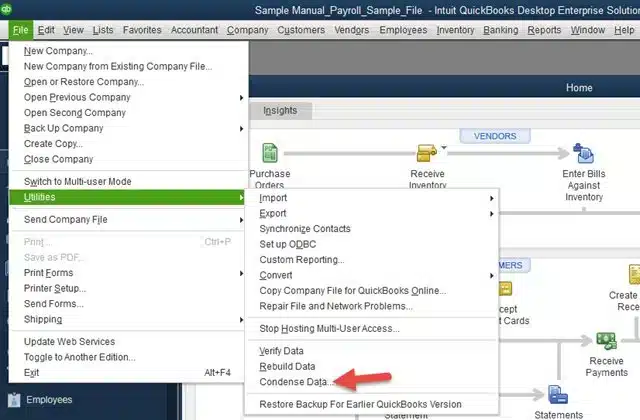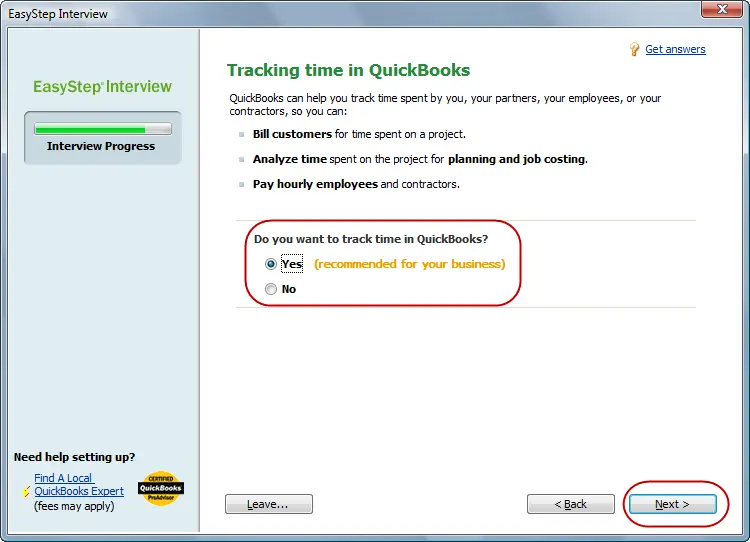A company file is a core element of QuickBooks and it is a must for every QuickBooks user to create one. It consists of all the crucial financial information of the company. QuickBooks lets a user to save multiple company files for multiple businesses separately. Creating a company file in QuickBooks or setting up a new company file in QuickBooks involves a bunch of steps. To help you setup a new company file in QuickBooks successfully, here we are with this segment. Stick around this segment to understand QuickBooks company files in a better way. On the contrary, if you are new and don’t want to risk your crucial data, simply reach out to our technical support team at +1-888-510-9198, and let our certified team professionals help you with your company file creation.
Having said that, let us unleash the entire process to create a company file in QuickBooks.
Setup a new company file in QuickBooks from scratch
This process will work if you are looking forward to create a new company file from scratch. However, if you already have an existing company file saved on your system, then make sure to use a different name for this one. Using the same name can cause to data loss as it might overwrite the existing file. The steps involved in this process of creating a new company file are:
- Open QuickBooks initially.
- Further, go for Create a new company option in the no company open window.
- This will further lead you to two different options i.e., Express start and Detailed start.

Let us understand the steps involved in both cases.
Option 1: Express Start
- In case you go for an express start, you simply need to choose express start to get it started right away.
- Further enter only the business name, industry, and type to setup a new company file in QuickBooks.
- You will have to open QuickBooks
- Further, click on Create a new company on the no company open window.
- After that, click on the express start tab.
- Enter the information in QuickBooks.
- Click on Help Me Choose to see a description for every business type and chart of accounts in QuickBooks.
- Later on, click on create company option.
- Start creating a chart of accounts, customers, and services, or skip it by clicking on the start working option.
Also Read: Fix QuickBooks Company File in Use Error
Option 2: Detailed start
Another option that you can opt for is a detailed start process, where you will have to perform the steps in a more detailed manner and enter all the information from the very initials.
- Begin by opening QuickBooks.
- Head to the no company open window.
- Click on create a new company.
- Further, opt for the detailed start tab.
- Enter the information on the easy-step interview screen and click on the next tab.
- Select the industry type and go for the next tab.
- You will then have to spot the type of business entity and further click on the next tab.
- The next step is to set the fiscal year for which you want to create a company file and click on the next tab.
- After that, set up the QuickBooks admin password and click on the next tab.
- Choose the location to save the company file and click on the save tab.
- The last step is to customize the QuickBooks software by clicking on the next tab and do it later by clicking on leave.
- After selecting any of the above options, perform the onscreen steps and complete the setup. Ensure to keep the earlier points in mind.
- End the process and start working on your company file.
Setting up a new company in QuickBooks
Towards the end of every year, QuickBooks accounting software permits the users to create new company file from existing in QuickBooks desktop. This is to cut down on the necessity to enter the data in every initial company file setup. Note that, it is not essential to close a company file at the end of every year. However, a few QuickBooks users prefer it to maintain proper records and avoid a pile-up of transactions over the course of years ultimately hampering the system’s productivity. Before beginning with the procedure to QuickBooks set up new company, let us unleash the benefits of starting a new company file at the end of the year.
Is creating a new year-end company file in QuickBooks beneficial?
Well, there are a few basic perks that are associated with the creation of a new company file toward the end of the year. Let us find out what those benefits are:
- Large files usually deteriorate the performance of a system. Thus, creating a new file at the end of the year divides the data into different files making it easy to store and avoiding any hamper to the system’s productivity.
- Another perk associated with this procedure is that it adds up to the data security against accidental data tempering, as it prevents any changes in the previous year’s tax reporting data.
- This feature can further be helpful in restructuring and cleaning up the current data by simply removing the unused items, accounts, and names.
Important points to implement before starting a new company file
Before you begin the process, it is essential to keep a check on the following pointers. Note that, you need to have an active subscription of either standard, basic, or enhanced payroll. Moreover, you will further have to print the reports mentioned later on December 31st of the closing year. These reports might be required when you recreate the year-end balances of the account receivables and accounts payable in the new company file. Not just that, these reports might further be required when you are recording the opening balances for all the balance sheet accounts. Also, you will have to enter the outstanding banking transactions, stock status, and inventory values.
- Customer balance detail report
- Here you need to head to the reports menu
- Move to Customers and Receivables option
- Select customer balance details
- Vendor balance detail report
- Navigate to the reports menu
- Choose vendors and payables and also select the vendor balance details option
- Standard balance sheets
- Head to the reports menu for standard balance sheets
- Go for the company and financials and select the balance sheet standard option.
You might find this helpful: Hosting QuickBooks Desktop Company File – Easy Steps
Setup a new company file in QuickBooks Pro and Premier
Below are some steps that would help you setup a new company file in QuickBooks Pro and QuickBooks Premier:
- Go to the ‘File’ menu, select utilities, and click on ‘Clean Up Company Data’

- Rebuild all the outstanding balances in the accounts receivable either by re-creating individual invoices or you can create balance forward invoices for a lump sum customer balance.
- From the ‘Vendors menu‘, recreate all the vendor balances along with the Enter Bills option.

- These bills will be directly charged to the ‘Uncategorized Expense Account‘ as opposed to individual expense accounts.
- The feature will not be available to payroll users due to critical payroll information in payroll files.
- The feature is not available to QuickBooks online banking users due to the security and time-related data from financial institutions.
Further steps are as below:
- Choose File > New Company

- Click on Start Interview in the window of EasyStep Interview.

- Follow all the instructions given on-screen and enter the information for your new company file.

Also Read: How to Setup QuickBooks Enterprise –Technical Support & Error Handling?
Winding Up!
This brings us to the end of this particular segment sharing details about how to set up a new company in QuickBooks successfully. Creating a company file isn’t a tough nut to crack if you have gone through the right steps to implement it. On the contrary, if you are still unable to create a company file or if you are dicey with the procedure, then do not hesitate in connecting with our technical support professionals using our toll-free QuickBooks support number i.e., +1-888-510-9198, and our expert will ensure to answer all your queries immediately.
FAQs Related to Set up a New Company File
You can have multiple companies under the same QuickBooks online account. Each company file is its own paid subscription. However, you can access them with the same sign-in info.
To open and use a secondary company file in QuickBooks. You can perform the below steps:
1. Double-click the second company file’s name.
2. After that, double-click the QuickBooks icon.
3. You now have to head to the file menu.
4. Further, choose open second company.
When you create a company file in QuickBooks, it creates a file with a .qbw extension. This file further holds your company file and the account info.
You can do this by performing the steps below:
1. Move to the file menu and further choose new company.
2. You now have to perform the onscreen instructions to set up a new company file for each business or location.
3. Once done with that enter the necessary information such as the company name and the contact information.
More Helpful Topics:
How To Restore a QuickBooks Portable Company File?
How to Fix QuickBooks Enterprise Setup and Installation Guide?


